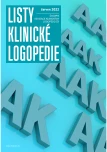ASSESSMENT OF SPEECH AND COGNITIVE FUNCTIONS 10 YEARS AFTER TRAUMATIC BRAIN INJURY IN ADOLESCENT: CASE STUDY
Authors:
Dzidová Lenka 1
Published in:
Listy klinické logopedie 2022; 6(1): 31-38
Category:
Main topic
doi:
https://doi.org/10.36833/lkl.2022.008
Overview
This paper deals with the case study of an adolescent after severe traumatic brain injury and its consequences, including the mention of prognostic factors and predictors of the development of the individual's state of health. It concerns a boy who, at the age of 13 years, suffered a serious brain injury - bleeding into the right lateral ventricle, frontal contusion on the right, diffuse brain oedema, multiple fractures of the right cranial vault and fractures of the facial bones. His epidural haematoma was evacuated on the right side of a decompression craniectomy. The boy was in a coma vigil for 4 months. In addition to initial basal stimulation and massage, he was given dysphagia therapy, performed breathing exercises, practised oral placement therapy, and used alternative communication at home with pictograms and pictures. 10 years after the accident, there was a sudden progression from the anarthria level to speech in words and phrases. Improvements were also seen in his cognitive function. Given the type, extent, location of brain damage and the severity of functional deficits, this case indicates a positive trend and possible rehabilitation potential, even in the late stages of rehabilitation.
Keywords:
Speech – traumatic brain injury – predictors – functional outcome
Sources
- ANDERSON, V., GODFREY, C., ROSENFELD, J. V., Catroppa, C. 2012. Predictors of Cognitive Function and Recovery 10 Years After Traumatic Brain Injury in Young Children. Pediatrics [online]. 129(2), s. 254-261 [cit. 8. 2. 2022]. Dostupné z: https://www.publications.aap.org/pediatrics/article-abstract/129/2/e254/32521/Predictors-of-Cognitive-Function-and-Recovery-10?redirectedFrom=fulltext
- BRICHTOVÁ, E., 2009. Specifika dětské neurotraumatologie. Pediatrie pro praxi [online]. 10(5), s. 294-298 [cit. 24. 1. 2022]. Dostupné z: https://www.pediatriepropraxi.cz/pdfs/ped/2009/05/03.pdf
- CATROPPA, C., ANDERSON, V., 2004. Recovery and predictors of language skills two years following pediatric traumatic brain injury. Brain and Language [online]. 88(1), s. 68-78. [cit. 8. 2. 2022]. Dostupné z: https://www.sciencedirect.com/science/article/abs/pii/S0093934X03001597
- CATROPPA, C., ANDERSON, V., 2006. Planning, problém-solving and organizational abilities in children following traumatic brain injury: Intervention techniques. Pediatric Rehabilitation [online]. 9(2), s. 89-97 [cit. 16. 2. 2022]. Dostupné z: https://www.tandfonline.com/doi/abs/10.1080/13638490500155458
- DZIDOVÁ, L., 2020. Návrh diagnostického nástroje pro hodnocení orofaciální oblasti u dospělých. Disertační práce. Olomouc: Univerzita Palackého Olomouc, Pedagogická fakulta.
- HEDÁNEK, J., ROUBÍČKOVÁ, J., 1997. Dysartrický profil – test 3F. Praha: DeskTop Publishing FF UK.
- CHIOU, K., JIANG, T, CHIARAVALLOTI, N., HOPTMAN, M. J., DELUCA, J., GENOVA, H. 2019. Longitudinal examination of the relationship between changes in white matter organization and cognitive outcome in chronic TBI. Brain Injury [online]. 33(7), s. 846-853 [cit. 4. 2. 2022]. Dostupné z: https://pubmed.ncbi.nlm.nih.gov/31017479/
- CHRISTENSEN, J. 2015. The Epidemiology of Posttraumatic Epilepsy. Seminars in Neurology [online]. 35(03), s. 218-222 [cit. 8. 2. 2022]. Dostupné z: https://www.thieme-connect.com/products/ejournals/html/10.1055/s-0035-1552923
- CHRISTENSEN, J., PEDERSEN, M. G., PEDERSEN, C. B., SIDENIUS, P., OLSEN, J., VESTERFAARD, M. 2009. Long-term risk of epilepsy after traumatic brain injury in children and young adults: a population-based cohort study. Lancet [online]. 373(9669), s. 1105-1110 [cit. 9. 2. 2022]. Dostupné z: https://pubmed.ncbi.nlm.nih.gov/19233461/
- JONSSON, C. A., HORNEMAN, G., EMANUELSON, I., 2004. Neuropsychological progress during 14 years after severe traumatic brain injury in childhood and adolescence. Brain Injury [online]. 18(9), s. 921-934 [cit. 24. 1. 2022]. Dostupné z: https://www.researchgate.net/publication/8484194_Neuropsychological_progress_during_14_years_after_severe_traumatic_brain_injury_in_childhood_and_adolescence
- MARQUEZ DE LA PLATA, C. D., HART, T., HAMMOND, F. M. a kol., 2008. Impact of age on long-term recovery from traumatic brain injury. Archives of Physical Medicine and Rehabilitation [online]. 89(5), s. 896-903 [cit. 24. 1. 2022]. Dostupné z: https://www.ncbi.nlm.nih.gov/pmc/articles/PMC2600417/
- SMRČKA, M., ŠVESTKOVÁ, O., NAVRÁTIL, O., 2013. Kraniocerebrální poranění a možnosti následné neurorehabilitace – popis problematiky a přehled literatury. Neurologie pro praxi [online]. 14(2), s. 80-83 [cit. 24. 1. 2022]. Dostupné z: https://www.solen.cz/pdfs/neu/2013/02/06.pdf
- STUSS, D. T., 2011. Traumatic brain injury relation to executive dysfunction and the frontal lobes. Journal of Trauma and Rehabilitation [online]. 24(6), s. 584-589 [cit. 16. 2. 2022]. Dostupné z: https://journals.lww.com/co-neurology/Abstract/2011/12000/Traumatic_brain_injury__relation_to_executive.12.aspx
- TEMKIN, N. R., 2003. Risk factors for posttraumatic seizures in adults. Epilepsia [online]. 44(10), s. 18-20 [cit. 9.2.2022]. Dostupné z: https://pubmed.ncbi.nlm.nih.gov/14511390/
- YEATES, K. O., SWIFT, E., TAYLOR, H. G., WADE, S. L., DROTAR, D., STANCIN, T., MINICH, N. 2004. Short – and long-term social outcomes following pediatric traumatic brain injury. Journal of the International Neuropsychological Society [online]. 10(3), s. 412-426 [cit. 8. 2. 2022]. Dostupné z: https://www.cambridge.org/core/journals/journal-of-the-international-neuropsychological-society/article/abs/short-and-longterm-social-outcomes-following-pediatric-traumatic-brain-injury/9059CCB1AC2C71B8A3037750CAB13F97
Labels
Clinical speech therapy General practitioner for children and adolescentsArticle was published in
Clinical speech therapy (Listy klinické logopedie)

2022 Issue 1
Most read in this issue
- FACILITATION-SYSTEMIC THERAPY
- PRACTICAL USE OF CORE VOCABULARY AND MODELLING IN AUGMENTATIVE AND ALTERNATIVE COMMUNICATION
- ALTERNATIVE AND AUGMENTATIVE COMMUNICATION IN AMYOTROPHIC LATERAL SCLEROSIS PATIENTS
- THE MOST IMPORTANT PARAMETERS OF BOTTLE NIPPLES CURRENTLY USED IN THE CZECH REPUBLIC FOR FEEDING PRETERM INFANTS WHO ARE HOSPITALISED
